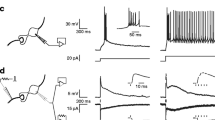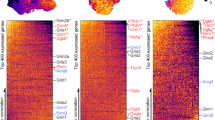Abstract
Unipolar brush cells (UBCs) are excitatory cerebellar granular layer interneurons whose brush-like dendrites receive one-to-one mossy fiber inputs. Subclasses of UBCs differ primarily by expressing metabotropic glutamate receptor (mGluR) 1α or calretinin. We used GENSAT Tg(Grp-EGFP) BAC transgenic mice, which selectively express enhanced green fluorescent protein (EGFP) in mGluR1α-positive UBCs to compare the functional properties of the two subclasses. Compared to EGFP-negative UBCs, which include the calretinin-positive cells, EGFP-positive UBCs had smaller somata (area 48 vs 63 μm2), lower specific membrane resistance (6.4 vs. 13.7 KΩ cm2), were less prone to intrinsic firing, and showed more irregular firing (in cell-attached ~49 % were firing vs. ~88 %, and the CV was 0.53 vs. 0.32 for EGFP-negative cells). Some of these differences are attributable to higher density of background K+ currents in EGFP-positive cells (at −120 mV, the barium-sensitive current was 94 vs. 37 pA in EGFP-negative cells); Ih, on the contrary, was more abundantly expressed in EGFP-negative cells (at −140 mV, it was −122 vs. −54 pA in EGFP-positive neurons); furthermore, while group II mGluR modulation of the background potassium current in EGFP-negative UBCs was maintained after intracellular dialysis, mGluR modulation in EGFP-positive UBCs was lost in whole-cell recordings. Finally, cell-attached firing was reversibly abolished by the GABAB activation in EGFP-positive, but not in EGFP-negative UBCs. Immunohistochemistry showed that EGFP-negative UBCs express GIRK2 at high density, while mGluR1α UBCs are GIRK2 negative, suggesting that GIRK2 mediates the mGluR-sensitive current in EGFP-negative UBCs. These data suggest that the two subclasses perform different functions in the cerebellar microcircuits.













Similar content being viewed by others
References
Nunzi MG, Shigemoto R, Mugnaini E. Differential expression of calretinin and metabotropic glutamate receptor mGluR1alpha defines subsets of unipolar brush cells in mouse cerebellum. J Comp Neurol. 2002;451:189–99.
Mugnaini E, Sekerková G, Martina M. The unipolar brush cell: a remarkable neuron finally receiving deserved attention. Brain Res Rev. 2010;66:220–45.
Diño MR, Perachio AA, Mugnaini E. Cerebellar unipolar brush cells are targets of primary vestibular afferents: an experimental study in the gerbil. Exp Brain Res. 2001;140:162–70.
Jaarsma D, Diño MR, Cozzari C, Mugnaini E. Cerebellar choline acetyltransferase positive mossy fibres and their granule and unipolar brush cell targets: a model for central cholinergic nicotinic neurotransmission. J Neurocytol. 1996;25:829–42.
Nunzi MG, Russo M, Mugnaini E. Vesicular glutamate transporters VGLUT1 and VGLUT2 define two subsets of unipolar brush cells in organotypic cultures of mouse vestibulocerebellum. Neuroscience. 2003;122:359–71.
Nunzi MG, Mugnaini E. Aspects of the neuroendocrine cerebellum: expression of secretogranin II, chromogranin A and chromogranin B in mouse cerebellar unipolar brush cells. Neuroscience. 2009;162:673–87.
Sekerková G, Ilijic E, Mugnaini E. Time of origin of unipolar brush cells in the rat cerebellum as observed by prenatal bromodeoxyuridine labeling. Neuroscience. 2004;127:845–58.
Dieudonné S. Submillisecond kinetics and low efficacy of parallel fibre-Golgi cell synaptic currents in the rat cerebellum. J Physiol. 1998;510(Pt 3):845–66.
Forti L, Cesana E, Mapelli J, D’Angelo E. Ionic mechanisms of autorhythmic firing in rat cerebellar Golgi cells. J Physiol. 2006;574:711–29.
Russo MJ, Mugnaini E, Martina M. Intrinsic properties and mechanisms of spontaneous firing in mouse cerebellar unipolar brush cells. J Physiol. 2007;581:709–24.
Russo MJ, Yau HJ, Nunzi MG, Mugnaini E, Martina M. Dynamic metabotropic control of intrinsic firing in cerebellar unipolar brush cells. J Neurophysiol. 2008;100:3351–60.
Diana MA, Otsu Y, Maton G, Collin T, Chat M, Dieudonné S. T-type and L-type Ca2+ conductances define and encode the bimodal firing pattern of vestibulocerebellar unipolar brush cells. J Neurosci. 2007;27:3823–38.
Ruigrok TJ, Hensbroek RA, Simpson JI. Spontaneous activity signatures of morphologically identified interneurons in the vestibulocerebellum. J Neurosci. 2011;31:712–24.
Simpson JI, Hulscher HC, Sabel-Goedknegt E, Ruigrok TJ. Between in and out: linking morphology and physiology of cerebellar cortical interneurons. Prog Brain Res. 2005;148:329–40.
Doyle JP, Dougherty JD, Heiman M, Schmidt EF, Stevens TR, Ma G, et al. Application of a translational profiling approach for the comparative analysis of CNS cell types. Cell. 2008;135:749–62. Erratum in: Cell 2009;139:1022.
Gong S, Zheng C, Doughty ML, Losos K, Didkovsky N, Schambra UB, et al. A gene expression atlas of the central nervous system based on bacterial artificial chromosomes. Nature. 2003;425:917–25.
Pearson K. On lines and places of closest fit to systems of points in space. Phil Mag. 1901;2:559–72.
Diño MR, Willard FH, Mugnaini E. Distribution of unipolar brush cells and other calretinin immunoreactive components in the mammalian cerebellar cortex. J Neurocytol. 1999;28:99–123.
Floris A, Diño M, Jacobowitz DM, Mugnaini E. The unipolar brush cells of the rat cerebellar cortex and cochlear nucleus are calretinin-positive: a study by light and electron microscopic immunocytochemistry. Anat Embryol (Berl). 1994;189:495–520.
Diño MR, Mugnaini E. Distribution and phenotypes of unipolar brush cells in relation to the granule cell system of the rat cochlear nucleus. Neuroscience. 2008;154:29–50.
Englund C, Kowalczyk T, Daza RA, Dagan A, Lau C, Rose MF, et al. Unipolar brush cells of the cerebellum are produced in the rhombic lip and migrate through developing white matter. J Neurosci. 2006;26:9184–95.
Chklovskii DB. Synaptic connectivity and neuronal morphology: two sides of the same coin. Neuron. 2004;43:609–17.
Peters A, Palay S, Webster dF. The fine structure of the nervous system: the neurons and supporting cells. Philadelphia: Saunders; 1976.
Dugué GP, Dumoulin A, Triller A, Dieudonné S. Target-dependent use of co-released inhibitory transmitters at central synapses. J Neurosci. 2005;25:6490–8.
Knoflach F, Kemp JA. Metabotropic glutamate group II receptors activate a G protein-coupled inwardly rectifying K+ current in neurones of the rat cerebellum. J Physiol. 1998;509(Pt 2):347–54.
Harashima C, Jacobowitz DM, Stoffel M, Chakrabarti L, Haydar TF, Siarey RJ, et al. Elevated expression of the G-protein-activated inwardly rectifying potassium channel 2 (GIRK2) in cerebellar unipolar brush cells of a Down syndrome mouse model. Cell Mol Neurobiol. 2006;26:719–34.
Aguado C, Colón J, Ciruela F, Schlaudraff F, Cabañero MJ, Perry C, et al. Cell type-specific subunit composition of G protein-gated potassium channels in the cerebellum. J Neurochem. 2008;105:497–511.
Patil N, Cox DR, Bhat D, Faham M, Myers RM, Peterson AS. A potassium channel mutation in weaver mice implicates membrane excitability in granule cell differentiation. Nat Genet. 1995;11:126–9.
Surmeier DJ, Mermelstein PG, Goldowitz D. The weaver mutation of GIRK2 results in a loss of inwardly rectifying K+ current in cerebellar granule cells. Proc Natl Acad Sci USA. 1996;93:11191–5.
Koyrakh L, Luján R, Colón J, Karschin C, Kurachi Y, Karschin A, et al. Molecular and cellular diversity of neuronal G-protein-gated potassium channels. J Neurosci. 2005;25:11468–78.
Misgeld U, Bijak M, Jarolimek W. A physiological role for GABAB receptors and the effects of baclofen in the mammalian central nervous system. Prog Neurobiol. 1995;46:423–62.
Reuveny E, Slesinger PA, Inglese J, Morales JM, Iniguez-Lluhi JA, Lefkowitz RJ, et al. Activation of the cloned muscarinic potassium channel by G protein beta gamma subunits. Nature. 1994;370:143–6.
Acknowledgments
This work was supported by NIH grant RO1 09904. Paraffin embedding and sectioning of the paraffin-embedded blocks was performed by Northwestern University Mouse Histology and Phenotyping Laboratory, which is supported by a Cancer Center Support Grant (NCI CA060553). The authors wish to thank Drs. Joe P. Doyle, Joseph D. Dougherthy, and Nataniel Heintz, The Rockefeller University, New York, NY, for breeding pairs of Tg(Grp-EGFP)DV197 mice.
Conflict of Interest
No conflict of interest exists for any of the authors.
Author information
Authors and Affiliations
Corresponding author
Rights and permissions
About this article
Cite this article
Kim, JA., Sekerková, G., Mugnaini, E. et al. Electrophysiological, Morphological, and Topological Properties of Two Histochemically Distinct Subpopulations of Cerebellar Unipolar Brush Cells. Cerebellum 11, 1012–1025 (2012). https://doi.org/10.1007/s12311-012-0380-8
Published:
Issue Date:
DOI: https://doi.org/10.1007/s12311-012-0380-8




